
Mr. Pierluigi Biasiolo “Antimicrobial/antiviral applications of transparent photocatalytic coatings” Authors: Raffaella Moro (*) (X), Angelo Del Favero (*), Pierluigi Biasiolo (**), Gian Luca Guerrini (*)(***) (X)
(*) Reair S.r.l., via Montenapoleone 10, 20121 Milan – Italy
(**) Reair Global, 468 N. Camden Drive, Beverly Hills, CA 90210 USA
(***) via I. Calvino, 7/Q 20063 Cernusco sul Naviglio – Milan – Italy
(X) Corresponding author – direzione@reair.it
Infections caused by microorganisms such as bacteria and viruses are a leading cause of disease and death worldwide. They can be transmitted especially in indoor environments both through respiratory droplet and contact routes. Although the most recent SARS COv-2 virus studies that have been carried out in the last year seem to attribute greater importance to the transmission of viral particles through the respiratory tract and therefore due to the presence of aerosols and droplets in the confined environments, the need to guarantee the cleaning, sanitation and sanitization of surfaces, which are also means of transmission of pathogens, remains fundamental, especially in hospitals but generally in public places.
Due to the COVID 19 pandemic, biological risk has thus become a new priority in the management of indoor environments which must therefore be sanitized through the adoption of clear and regular operating protocols.
Surfaces are sanitized mainly using chemical disinfectants which are effective but have an instant and not a lasting benefit. Therefore, it becomes important to propose protocols where photocatalytic products are used in order to guarantee a long duration and efficacy. In this case, we will reduce considerably tthe use of large quantities of chemical products that have a negative impact on the environment (pollution), and on the occupants wellbeing.
Transparent coatings that do not change the surface appearance and colour of the substrates, adhere and adapt to all curves, are among the most easily applicable photocatalytic products with a relatively low economic impact. The other surface coating materials are white, coloured paints or varnishes, or they are rigid flat products (tiles, panels) generally usable for new projects or for renovations, with costs per square meter often not exactly negligible (beyond the specific photocatalytic performances that are provided). They are also active inside buildings in both natural and artificial light conditions.
Finally, photocatalytic products must guarantee efficacy, long life against microorganisms and their performances must be measurable and monitorable over time, through certified tools that quantify the presence of microorganisms on surfaces (such as the bio-luminometer). The treated surfaces can be vertical and of various types of materials (walls, partitions, glass, concrete, fabrics) and other in direct contact with the people (tables, chairs, worktops, work tools). In this work, an example of a protocol proposed for the photocatalytic treatment of indoor environments will be presented and some examples of recently completed applications in different sectors (for example: hospitals, schools, airport infrastructures, offices, shops, medical centres, ships).


“Homogeneous photocatalytic reduction of CO2“
Dr. Claudia Bizzarri – Independent Junior Group Leader, Karlsruhe Institute of Technology, Institute of Organic Chemistry, Germany
Brief description of talk: Solar energy is the only renewable and carbon-neutral energy source of sufficient scale to replace fossil fuels.[1] The direct conversion of light into chemical bond energies has the advantage over photovoltaics to be able to store large amount of energy in form of chemicals. Important milestones have been recently achieved on artificial photosynthesis,[1b-1c] nevertheless in terms of applicability, these photosensitizers should be easily available and cost-effective, thus, earth-abundant materials are highly desired.[2-3]
New bis(dipyrrinato) Zn(II) complexes[3] and new heteroleptic Cu(I) complex (mononuclear and multinuclear), obtained by modification of the diimine ligand, based on substituted 1,2,3-1H-triazole,[2] are presented. We explore their photophysical and electrochemical properties, revealing that these metal complexes possess an unordinary high photoluminescence quantum yield. Further strategies to lower non-radiative constants will be discussed, as the use of mesoporous silica.[4] Finally, some experiments on photoreduction of carbon dioxide are presented.[5]
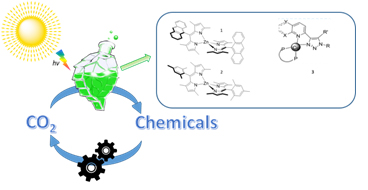
Literature:
[1] (a) N. Armaroli; V. Balzani; Chem. Eur. J., 2016, 22, 32-57 ; (b) S. Berardi, et al., Chem. Soc. Rev. 2014, 43, 7501-7519 ; (c) M. Heberle, et al. Chem Eur. J. 2017, 23, 312–319.
[2] C. Bizzarri, A. P. Arndt, S. Kohaut, K. Fink, M. Nieger J. Organometallic Chemistry 2018, 871, 140-149.
[3] D.Tungulin, J. Leier, A. B. Carter, A. K. Powell, R.Q. Albuquerque, A-N. Unterreiner, C. Bizzarri, Chem.Eur. J. 2019, 25, 3816.
[4] U.Sani, D. Tungulin, C.Bizzarri, F. Cucinotta, RSC Advances 2020, 10, 2841-2845.
[5] (a) L.-L. Gracia, L. Luci, C. Bruschi, L. Sambri, P. Weis, O. Fuhr, C.Bizzarri Chem Eur J. 2020, 26, 9929-9937.(b) C. Bruschi, X. Gui, N. Salaeh-arae, T. Barchi, O. Fuhr, S. Lebedkin, W. Klopper, C.Bizzarri, submitted.

“New insights into Nanomaterials for Photocatalytic Applications” Prof. Dr. Suresh C. Pillai, Centre for Precision Engineering, Materials and Manufacturing Research & Nanotechnology Research Group, Department of Environmental Science, Institute of Technology Sligo, Ash Lane, Sligo, Ireland
Brief description of talk: Functional semiconductor nanomaterials which could show photocatalytic activities under the natural light (typically >400 nm) is preferred for industrial applications. As part of a program to develop efficient surface coatings, our investigations were focused in the development of novel catalysts for anti-bacterial applications. Anatase phase of TiO2 thermally stable up to the sintering temperature of the substrates (e.g., bathroom tiles) is most desirable for building materials applications. Anatase phase thermal stability at elevated temperatures is one of the requirements for making such coatings on industrial scale. The preparation of novel photo-catalytic materials by modifying the band-gap using various dopants such as F, S, N and C will be discussed.
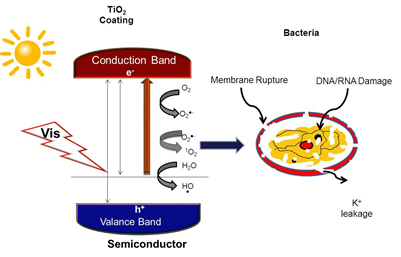
References
New insights into the efficient charge transfer of ternary chalcogenides composites of TiO2.” Priyanka Ganguly, Marica Muscetta, Nisha T. Padmanabhan, Laura Clarizia, A. Akande, Steven Hinder, Snehamol Mathew, Honey John, Ailish Breen, and Suresh C. Pillai. “ Applied Catalysis B: Environmental 282 (2021): 119612.
Graphene coupled TiO2 photocatalysts for environmental applications: A review.” Padmanabhan, Nisha T., Nishanth Thomas, Jesna Louis, Dhanu Treasa Mathew, Priyanka Ganguly, Honey John, and Suresh C. Pillai. Chemosphere (2021): 129506.
“Recent advances in photocatalysis for environmental applications.” Journal of Environmental Chemical Engineering C. Byrne, G. Subramanian, and S. C. Pillai. 6, (2018), 3531-3555.
Visible-light activation of TiO2 photocatalysts: Advances in theory and experiments, V. Etacheri, C. Di Valentin, J. Schneider, D. Bahnemann, and S. C. Pillai, Journal of Photochemistry and Photobiology, 25 (2015) 1–29
New insights into the mechanism of visible light photocatalysis.” S. Banerjee, Suresh C. Pillai, P. Falaras, K. E. O’shea, J. A. Byrne, and D. D. Dionysiou. The journal of physical chemistry letters 5, (2014): 2543-2554.
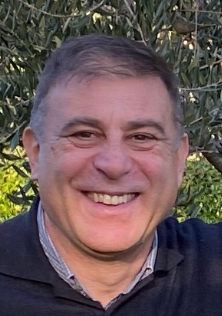
“Photocatalysis and virus: an industrial perspective”
Ing. Dr. Gian Luca Guerrini – Industrial innovation specialist for photocatalysis – Italy
Brief description of talk: The ongoing pandemic situation due to the spread of the SARS COv-2 virus has created considerable applicative interest for photocatalysis technology for improving indoor air quality, with reference to microorganisms.
In this talk, the main mechanisms that can be exploited for the inactivation of viruses and for their killing – in other words, for an effective sanitization of the environments – are briefly described and the main results obtained in terms of research and product development are also reported.
Further, the most promising and innovative solutions both for surface sanitization and for air purification are highlighted, and some commercial products are also described: several solutions can be adopted, depending on the different situations (small and medium-sized or large public and private environments, such as schools, banks, airports, hospitals, shopping malls, industrial and commercial environments, sports centres and gyms).
Indeed, it is a question of distinguishing between an air purification/sanitization and a surface sanitization. The two solutions are not competing, they can be adopted individually according to the environmental situations and the places on which we intend to intervene, but they even complement each other and can be adopted for a complete treatment of air and surfaces.
The technology of photocatalysis will be compared with other solutions currently suggested for the inactivation of viruses, to demonstrate that:
– It is a valid, economical and environment friendly solution as an alternative for disinfecting chemicals currently used for surfaces and indoor environments (it is a physical treatment that generates active products in situ);
– It is a solution which can be adopted in combination with other techniques (e.g. mechanical filtration and/or electrostatic treatment) for a highly effective air purification.
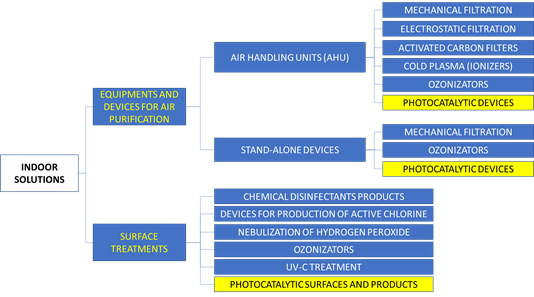

“Access to advanced nanoelectronics and power the IoT infrastructure in Europe” Dr. Nicolas Cordero – Research Cluster, Tyndall National Institute, Ireland
Title: Access to advanced nanoelectronics and power the IoT infrastructure in Europe
Authors: Giorgos Fagas, Mike Hayes, Paul Roseingrave and Nicolas Cordero, Tyndall National Institute, University College Cork, Ireland
Brief description of talk: Development of nanomaterials and their integration into device, from fundamental research to market-ready applications, requires access to advanced tools and expertise that may not be readily available within local networks of academic researchers or companies. Accordingly, the distributed research infrastructure model is particularly suited for supporting and promoting research and innovation in nanotechnology-based products and nanoelectronics. In this talk we introduce two such EU-funded programmes – ASCENT+ and EnABLES, both led by Tyndall National Institute – that offer free-of-charge access to world-leading infrastructure for advances in nanoelectronics and for addressing energy harvesting, storage and management in autonomous devices.
ASCENT+ mobilises an unprecedented network of knowledge and investment, bringing together 15 partners to foster the Nanoelectronics community. ASCENT+ serves as a direct entry point to a European Nanoelectronics Research Infrastructure of global scale offering access to key enabling capabilities in state-of-the-art processing, modelling and simulation data sets, metrology and characterisation, and devices and test structures. Focus areas include:
– Quantum advantage using solid-state platforms
– Low-power, energy-efficient, high-performance computing based on disruptive devices
– Increased functionality through advanced integration of a diverse range of materials and innovative technologies
ASCENT+ offers an unparalleled opportunity to users, empowering them to respond to new problems and to advance knowledge and technology through generating novel results. ASCENT+ enables and stimulates its user community to bridge the gap between scientific exploration and development of proof-of-concept technologies to accelerate innovation pathfinding.
EnABLES integrates key European research infrastructures in powering the Internet of Things (IoT). Six research institutes together with 5 knowledge hubs of excellence address the long-term needs of energy management in self-powered smart sensor systems as required by IoT innovation. Through providing access to unique infrastructure, world-leading expertise, advanced equipment and state-of-the-art technologies, EnABLES empowers hundreds of academic researchers and technologists to advance energy harvesting, storage and micro-power management solutions for the integrated design and deployment of miniaturised autonomous sensors. Nanotechnology offers many opportunities to enhance material/device performance as well as miniaturize ‘power IoT’ solutions. Access ranges from materials & models to devices and systems and the access providers work with the user community to accelerate adoption and innovation in real-life applications. The EnABLES integration offers a paradigm shift in building an infrastructure network that links new scientific knowledge with application-driven research.
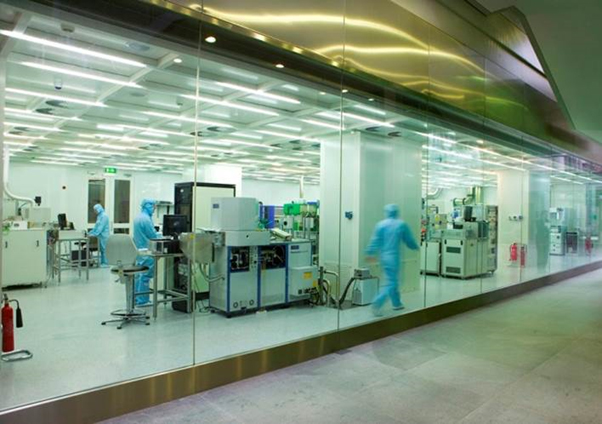

“Water and wastewater treatment by heterogeneous photocatalysis: results, process limitations and prospects”, Dr. Luigi RIZZO, Associate Professor of Sanitary and Environmental Engineering, Coordinator of the “International PhD School on AOPs”, Water Science and Technology (WaSTe) group leader, Department of Civil Engineering, University of Salerno
Brief description of talk: Although heterogeneous photocatalytic processes (HPPs) have been widely investigated in water and wastewater treatment, even with interesting and encouraging results, different obstacles to their application at full scale still exist. In this talk the results from investigations of HPPs will be introduced and discussed with regard to different pollutants and water matrices. In particular, the application of HPPs to drinking water treatment for the oxidation of As(III) to As(V) as well as for surface water disinfection respectively, will be discussed. Moreover, the possible application of HPPs as advanced treatment method of urban wastewater for the removal of contaminants of emerging concern and inactivation of (antibiotic resistant) pathogens, will be also addressed. Industrial wastewater treatment by HPPs will be introduced through examples related to food azo dyes and wastewater containing sugars. In particular, the investigation of agro-food wastewater treatment by HPPs is of interest also in relation to the possibility of energy recovery. For example, hydrogen production during photocatalytic treatment of wastewater containing high concentrations of sugars (particularly glucose) is a potential attractive option for producing energy while removing pollutants from the water matrix. Finally, the limitations of HPPs and possible competition with consolidated or short term perspective technologies for water and wastewater treatment will be discussed.

“Bacterial inactivation at the interface of sputtered photocatalytic surfaces without ions release: photo-generated intermediates and possible mechanisms.”
Dr. Sami Rtimi – Global Institute for Water, Environment and Health, Geneva, Switzerland
Brief description of talk: When contaminated with infectious agents, fomites can transfer disease to a new host. In the last years, the role of fomites in disease transfer is higher than ever. Europeans and Americans spend more than 80% of their time indoor [1]. Fomites are associated particularly with hospital-acquired infections (HAIs), as they are possible routes to pass pathogens between patients. It worries epidemiologists and hospital practitioners because of the growing selection of microbes resistant to antibiotics. Today, there is an urgent need for solutions allowing contact microbial adhesion and killing on different fomites’ materials.
Catalytic materials/surfaces are attracting a lot of attention during the last decade. However, very few research groups tried to focus on novel materials showing long-lasting catalytic activity killing/inactivating microbes (bacteria, virus, fungi…) [2]. Advanced antibacterial coatings presenting uniform particles distribution, high adhesion to the substrate, mechanical resistance and faster bacterial/biofilm inactivation under light or in the dark are needed due to health concerns. TiO2 films have been used under light < 387 nm generating highly oxidative radicals as bactericide films for many years. However, its restricted absorption of solar/visible light and slow bacterial inactivation kinetics has motivated researchers to couple TiO2 with metals (i.e. Cu, Au, Ag or Fe) to shift the light absorption of the films to the visible region [3,4]. In this talk, I will show the coupling of wide bandgap (WBG) semiconductors with narrow bandgap (NBG) metal oxides leading to bacterial/microbial inactivation in the minute range under low intensity indoor light. A brief comparison of the bactericidal activity of NBG bimetal oxides’ system compared to WBG will be presented and discussed. Future trends in this field will also be discussed [5].
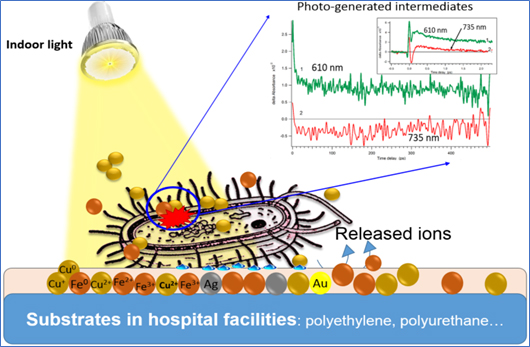
References:
[1] https://www.epa.gov/report-environment/indoor-air-quality
[2] S. Rtimi, S. Catalysts, 2017, 7(2), p57
[3] S. Rtimi et al., Applied Catalysis B: Environmental, 2017, 208, pp. 135–147
[4] A. Graf et al., ACS Applied Materials and Interfaces, 2019, 11(48), pp. 45319–45329
[5] Z. Liang et al., Applied Catalysis B: Environmental, 2019, 241, pp. 256–269
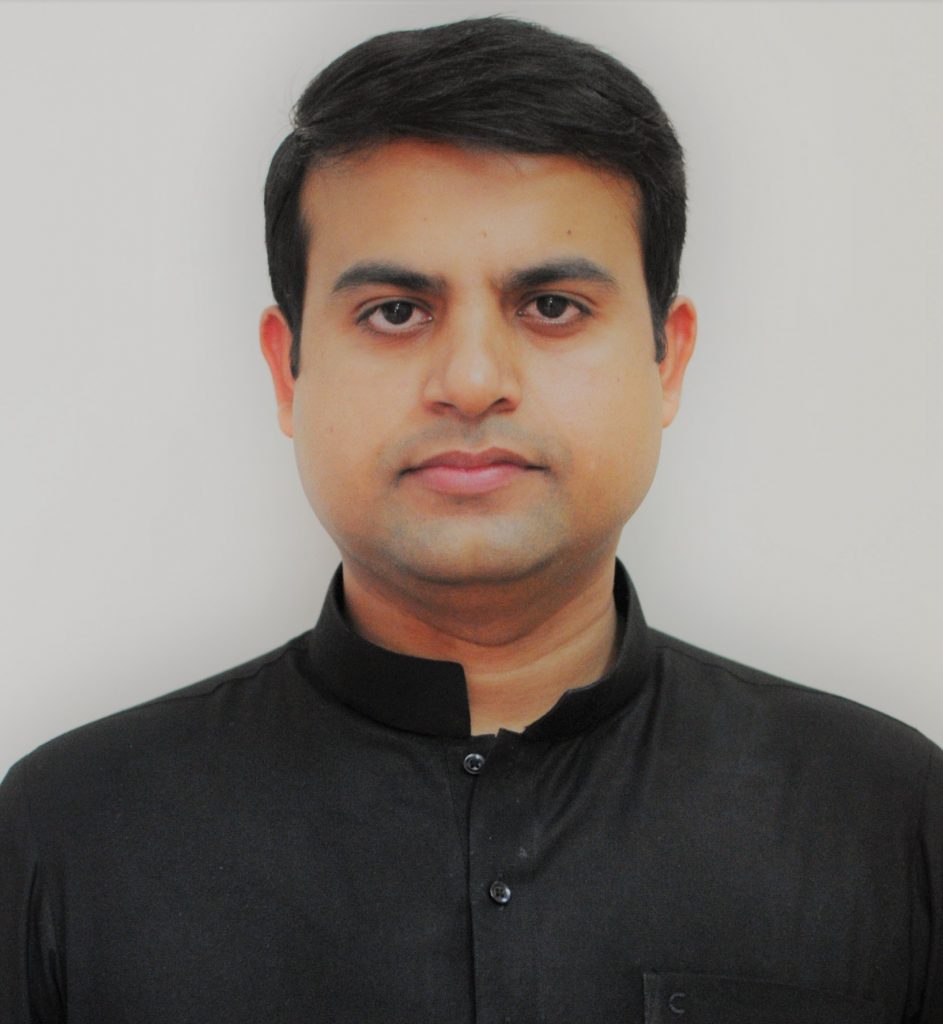
“Tuning Surface Chemistry of Black Anatase TiO2 Nanofibers for Photocatalytic Applications” Dr. Muhammad Fahad Ehsan – School of Natural Sciences (SNS), National University of Sciences and Technology (NUST) Islamabad, Pakistan
Tuning Surface Chemistry of Black Anatase TiO2 Nanofibers for Photocatalytic Applications
Muhammad Fahad Ehsan, Saher Hamid, Albert Collins, Ali Shafiee, Xu Zhang
Brief description of talk: This work is an appraisal for the photocatalytic degradation of the doxorubicin (DOX), a model antibiotic and a highly toxic chemotherapeutic pharmaceutical employing black titanium dioxide (b-TiO2) nanofibers as the potential photocatalyst. Here, the surface chemistry was primarily studied to understand the adsorption/desorption kinetics of DOX onto the surface of b-TiO2. The mode of interaction between DOX and b-TiO2 was also confirmed via Raman spectroscopy and X-ray photoelectron spectroscopy (XPS). In addition to this, we have also investigated the generation of different reactive oxygen species (ROS) including hydroxyl radicals (•OH), singlet oxygen (1O2), and superoxide anion radical (•O2−) responsible for the DOX degradation at the surface of the b-TiO2 using electron paramagnetic resonance (EPR) spectrophotometer. The obtained data exhibited the formation of •O2− as primary oxidants in the overall reaction. These results were further supported by the alignment of energy levels plotted vs. the standard hydrogen electrode (SHE) which also asserted the possibility of •O2− formation as the major reaction intermediate. Finally, the kinetic studies revealed that almost 70% of the DOX was degraded in about < 10 minutes. Compared with the photodegradation of non-adsorbed DOX species in solution (pH 4), the adsorption-dependent surface oxidation (pH 7) by light-induced holes on b-TiO2 was more efficient, which means that the adsorption of DOX particles is the rate determining step to achieve an efficient degradation. Finally, the liquid phase analysis for the degradation products was also performed by mass spectrometer.
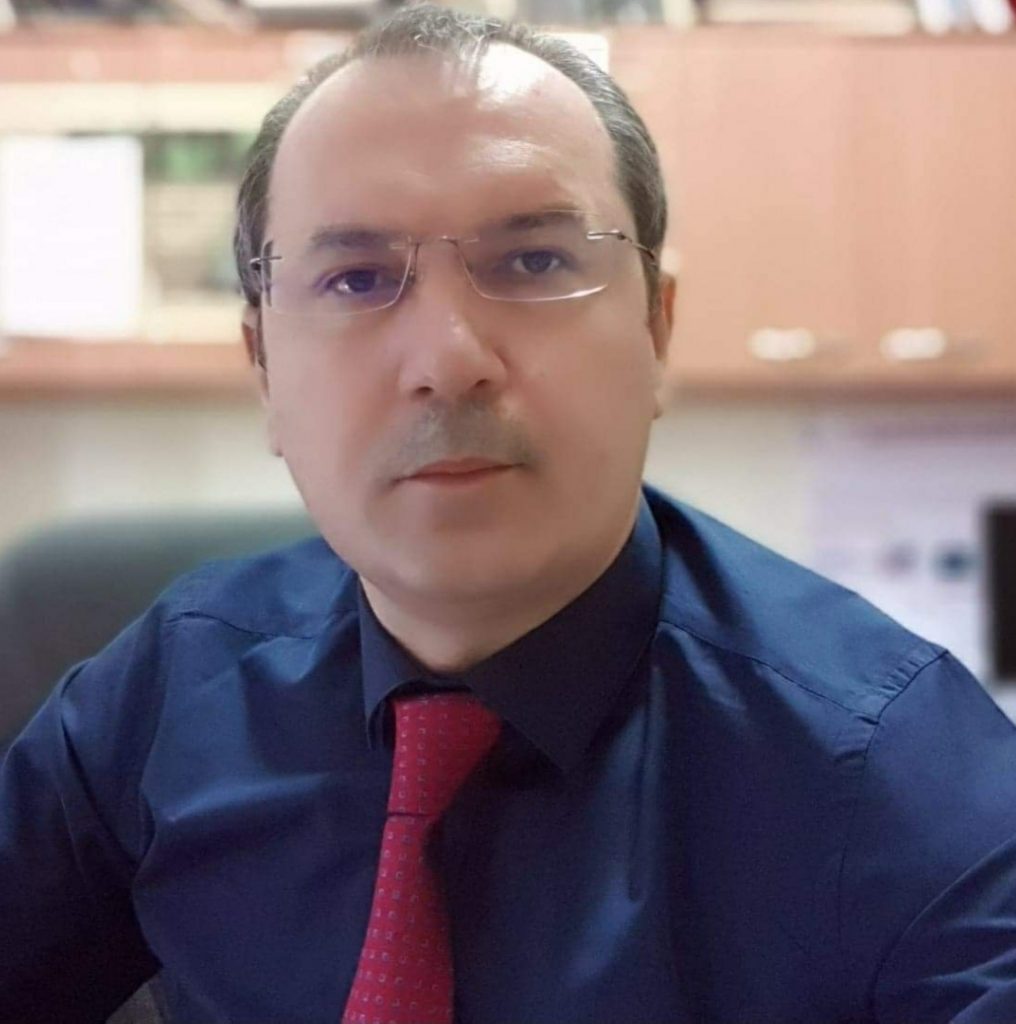
“Trace elements Photo-Analysis for environmental applications: a case study” Assoc. Prof. PhD Habil. Silviu-Octavian Gurlui, Head of Atmosphere Optics, Spectroscopy and Lasers Laboratory (LOA-SL), Alexandru Ioan Cuza University of Iasi, Faculty of Physics, Romania
Trace elements Photo-Analysis for environmental applications: a case study
Alexandru COCEAN, Iuliana COCEAN, Georgiana BULAI, Cristina POSTOLACHI, Bogdan MUNTEANU, Nicanor CIMPOESU, Silviu GURLUI
Brief description of talk: The origin of rare fragments space rocks fallen on the ground in Ipate area (Iasi County, Romania) following a huge sonic boom felt over a large area of Iasi County was investigated based on the trace elements Photo-Analysis. The material of the samples proved to be insoluble in all the solvents used for tests (water and organic solvents) which makes it be assigned as insoluble organic material (IOM). This, together with the functional groups resulting from the FTIR analysis denoting vibrations similar to those identified on the FTIR spectra of the Murchison, Bells and Allende carbonaceous chondrite meteorite samples raised the question on the nature of the fallen fragments, in correlation with the high intensity sonic boom. Thus, the presence of aromatic and aliphatic compounds, carboxylic acids and / or amino acids, amides, as well as silanol or Si-O groups, carbonates, but also C60 fullerene structures were identified. Water adsorbed on the surface of the material was also identified on the FTIR spectra, as well as adsorbed CO2. Thorium oxide specific vibrational bands were also observed on FTIR spectra. The investigation on the chemical composition was completed by the analysis of the elemental composition in EDS and LIBS. Analyzing the images acquired with electron microscopy technic (SEM), the morphology and topography of the fragments’ surfaces studied in different conditions (bulk and powder) evidenced structures that may be assigned to chondrules and chondrites of carbonaceous meteorites (CM). By mapping the elements identified with EDS on the SEM images, inclusions of calcium and aluminum (CAI), Fe-Ni (Kamacite) and FeS (Troillite), carbonaceous chondrites (CC) with carbon bound to O and S, thorium as ThO2 were highlighted, as well as finely dispersed or aggregated SiO2. Crystalline structures were identified in the diffraction patterns obtained by XRD and in the baseline of the FTIR spectra. All the information gathered by these complex analyses and the association with the sonic boom that preceded the fall of the studied fragments provide a number of data and clues that make of interest to further studies on the subject. Keywords: carbonaceous chondrite, meteorites, LIBS, volatile meteorites, crystallinity

“Synthesis of ZnO with enhanced photocatalytic activity using a sacrificial biomass support and Li2O as doping agent“
Dr. Alexandra Mocanu – Faculty of Applied Chemistry and Materials Science, “Politehnica” University of Bucharest, Romania
Synthesis of ZnO with enhanced photocatalytic activity using a sacrificial biomass support and Li2O as doping agent
Aurel Diacon, Alexandra Mocanu, Cristian Eugen Răducanu, Cristina Busuioc, Raluca Șomoghi, Bogdan Trică, Adrian Dinescu, Edina Rusen
Brief description of talk: Our study was focused on the synthesis of photocatalytic materials for the degradation of organic dyes based on the valorization of biomass resources.
The conversion of biomass into new products with added value can be achieved through different processes such as: combustion, torrefaction, liquefaction, gasification and pyrolysis [1]. According to European Directive 2008/98/EC, pyrolysis is considered a recovery operation and recycling technology [2] that contributed to the obtaining of bio-char from pyrolysis of biomass [3] due to its decontamination potential and disinfection characteristics. In this study, the biochar resulted from pyrolysis process of cherry pits. Activated (by CO2) flow and inactivated carbon was used to obtain carbon-based photocatalysts impregnated with different zinc salt precursors. The activation of carbon had no significant influence on the photodegradation process. Based on different synthesis procedures, one of our aims was to use an “in situ” synthesis method with the advantages of an “ex situ” technique [4]. Therefore, our approach involved the use of several zinc salts aqueous solutions to impregnate the biochar structure followed by solvent removal and calcination of the biochar and generation of semiconductor materials in order to investigate the effects on the morphology of the obtained ZnO and its photocatalytic activity. Doping agents like copper, yttrium, silver, cerium, etc. ranging from 1 to 5% in weight were used to decrease the energy band-gap of ZnO or TiO2 [5] in order to create oxygen vacancies and prevent the recombination of electron-hole (e− − h+) pairs, thus increasing their photocatalytic activity also in visible light. Until now, few studies demonstrated that the use of Li2O as dopant may enhance the performance of certain metal oxides like Co3O4, Mn2O3, CuO, in terms of catalytic activity or sensitivity [6] due to the morphologic modifications that appear during the synthesis process which led to increased specific surface area of the inorganic final materials. Thus, the aim of our study was to investigate the role of biomass carbon as support on one hand, and the role of Li2O as dopant (using Li2CO3 with concentrations as precursor) on the other, for ZnO-based photocatalytic structures for the decomposition of methyl orange. The presence of Li atoms led to photocatalytic activities of the doped ZnO similar to the undoped ZnO obtained at higher concentrations of zinc acetate precursor.
References:
[1] Leng, L. et al. Surface characterization of rice husk bio-char produced by liquefaction and application for cationic dye (Malachite green) adsorption. Fuel 155, 77, https://doi.org/10.1016/j.fuel.2015.04.019 (2015).
[2] Dias, D. et al. Properties of chars from the gasification and pyrolysis of rice waste streams towards their valorisation as adsorbent materials. Waste management 65, 186, https://doi.org/10.1016/j.wasman.2017.04.011 (2017).
[3] Tripathi, M., Sahu, J. N. & Ganesan, P. Effect of process parameters on production of biochar from biomass waste through pyrolysis: A review. Renewable and Sustainable Energy Reviews 55, 467, https://doi.org/10.1016/j.rser.2015.10.122 (2016).
[4] Pan, X. & Xu, Y.-J. Graphene-Templated Bottom-up Fabrication of Ultralarge Binary CdS–TiO2 Nanosheets for Photocatalytic Selective Reduction. The Journal of Physical Chemistry C 119, 7184, https://doi.org/10.1021/jp512797t (2015).
[5] Vakili, B. et al. Synthesis of immobilized cerium doped ZnO nanoparticles through the mild hydrothermal approach and their application in the photodegradation of synthetic wastewater. Journal of Molecular Liquids 280, 230, https://doi.org/10.1016/j.molliq.2018.12.103 (2019).
[6] El-Shobaky, G. A., El-Shobaky, H. G., Badawy, A. A. & Mohamed, G. M. Effect of Li2O – Doping on physicochemical, surface and catalytic properties of nanosized CuO–Mn2O3/cordierite system. Mater Chem Phys 136, 1143, https://doi.org/10.1016/j.matchemphys.2012.08.067 (2012).
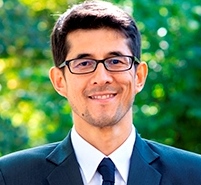
“Transition metal sulfides-based photocatalytic materials derived from mining and metallurgical wastes“
Dr. Mirabbos Hojamberdiev– Institut für Chemie, Technische Universität Berlin, 10623 Berlin, Germany
Brief description of talk: Over 100 billion tons solid wastes from mining and metallurgical industries are generated annually worldwide. Due to their low intrinsic values and the remote location of most mining operations, over 95% of wastes end up being disposed in landfills, which have an irreversible damage to the environment and constitute a hazard to humans. Therefore, a circular economy model must be formed, which promotes zero waste generation through recycling and re-use of these waste materials and reduces the cost of final products. In this study, ZnS- and MoS2-containing wastes from the mining-metallurgy industry were characterized as useful photocatalysts and sensors. Trigonal ZnIn2S4 layered crystals were synthesized by a binary-flux method using the ZnS-containing waste. Among the binary fluxes used, the KCl:InCl3 was found to be the most favorable for the synthesis of phase-pure trigonal ZnIn2S4 layered crystals. The UV-vis diffuse reflectance spectrum exhibited the onset of the absorption edge at approximately 700 nm for trigonal ZnIn2S4 layered crystals. The presence of secondary crystalline phases (ZnS or In2S3) in ZnIn2S4 layered crystals grown using NaCl:InCl3 and CaCl2:InCl3 fluxes improved the photocatalytic activity, and the photocatalytic H2 evolution rates reached 188 μmol·h–1 and 232 μmol·h–1, respectively, because of efficient separation and transfer of photogenerated charge carriers (Figure 1). The antibacterial activity of ZnS-containing industrial waste against four bacterial strains was studied under UV light irradiation. The antibacterial activity against L. innocua was comparable to that against MRSA. The inactivation rate against E. coli reached 99% within 2 hours of UV light irradiation, while the inactivation of S. enteretidis was less effective. Next, we have characterized molybdenite concentrate from the mining-metallurgy industry as a valuable starting material for the fabrication of an efficient and low-cost nanostructured gas sensor. After liquid nitrogen exfoliation, impurities were removed, and the enriched molybdenite-2H was deposited on different substrates by spin coating and drop casting. It was found that spin coating was advantageous over drop casting in fabricating a homogeneous and dense molybdenite-2H film. The gas sensing behavior of the fabricated sensor was studied for different concentrations of NO2 at different temperatures. It was found that the temperature strongly influences the key sensing parameters of the device. The sensing behavior of the fabricated device was explained based on the charge-transfer mechanism. The findings of this study reflect a straightforward approach for converting metal sulfide-containing industrial wastes into an efficient photocatalysts and sensors.
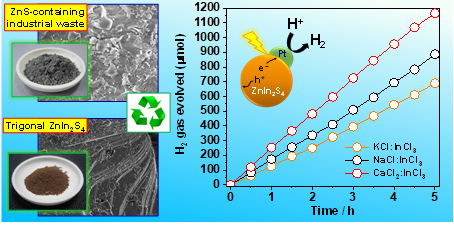

“Photocatalytic organic synthesis: from nanomaterials to process intensification” Prof. Dr. Cláudia Gomes Silva Laboratory of Separation and Reaction Engineering – Laboratory of Catalysis and Materials (Associate Laboratory LSRE-LCM), Faculty of Engineering, University of Porto, Portugal
Brief description of talk: The cost-effective and environmental-sustainable production of pharmaceutical ingredients, agrochemicals, nutrition components, flavors and fragrances gained increasingly importance in the present economy. In general, heterogeneous photocatalysis has been appointed as a promising alternate route for chemical synthesis of base chemicals for those applications. Compared to conventional processes, it has the enormous advantage of operating under mild temperature, exempted of using hazardous reagents and with the prospect of using low energy consumption irradiation sources. Moreover, specific types of reactions can be undertaken at high conversions and yields. The key for the application of such processes lays in the successful combination of effective (photo)catalysts, energy-efficient light sources, and reactor engineering.
Graphite-like carbon nitride (g-C3N4) is a polymeric semiconductor which may be regarded as “doped” graphite in which carbon atoms are regularly substituted by nitrogen atoms. The main bottlenecks for the application of this metal-free photocatalyst are the low surface area and the low photonic efficiency. This talk will present several approaches for boosting the activity of g-C3N4 for photocatalytic organic synthesis. In addition, the use of such materials in structured photoreactors, seeking for process intensification, will be discussed.
Acknowledgements: This work was financially supported by the Base Funding of the Associate Laboratory LSRE-LCM (UIDB/50020/2020), financed by national funds through FCT/MCTES (PIDDAC) and by the Project POCI-01-0145-FEDER-031398 funded by the European Regional Development Fund (ERDF) through COMPETE2020 – Programa Operacional Competitividade e Internacionalização (POCI) – and by national funds through FCT – Fundação para a Ciência e a Tecnologia.

“Plasmonic photocatalytic for environmental applications” Prof. Dr. Ewa Kowalska Institute for Catalysis (ICAT), Hokkaido University, Sapporo, Japan
Brief description of talk: Plasmonic photocatalysts, wide-bandgap semiconductors modified with noble metals (NMs) with activity under vis irradiation due to surface plasmon resonance, have been extensively investigated as a possible solution to energy and environmental problems. Although various reports on plasmonic photocatalysts have already been published, the quantum yields of photochemical reactions are usually too low for commercialization [1]. It has been proposed that preparation of plasmonic photocatalysts with efficient light harvesting and inhibition of charge carriers’ recombination might result in improvement of photocatalytic activity. Among various strategies, nano-architecture of plasmonic photocatalysts seems to be one of the best methods, including the design of properties for both semiconductor and NMs, as well as the interactions between them [2-3].
Accordingly, our studies have focused on preparation of plasmonic photocatalysts by various approaches, including (i) efficient light harvesting, e.g., polydispersity of NMs (Larger mean size of NM NPs correlates with higher polydispersity in their size and shape.), bi-/tri-metallic photocatalysts, plasmonic photocatalysts co-modified with other absorbing components (ruthenium complexes [4]), and incorporation of NMs inside voids of inverse opal titania structures with slow-photon effect [5], and (ii) fast “hot” electron transfer. Interestingly, it has been found that some highly UV-active titania-based photocatalysts, e.g., NM-modified decahedral anatase particles (DAP) with two kinds of facets ({101} and {001}), show negligible vis activity (Fig. 1), due to unwanted charge carriers’ recombination [6]. In contrast, another faceted anatase titania with only one type of facet ({101}–octahedral anatase particles; OAP) exhibits photocatalytic activity one order of magnitude higher, being the most active titania-based particulate photocatalyst (among tested samples), probably due to fast “hot” electron transfer via shallow electron traps [6-8]. The properties, activities (hydrogen evolution, decomposition of organic compounds and microorganisms’ inactivation) and mechanisms’ clarifications will be discussed during presentation.
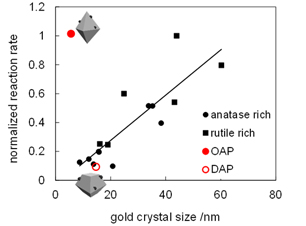
[1] E. Kowalska, R. Abe, B. Ohtani, Chem. Commun., 2009, 2, 241-243.
[2] T. Raja-Mogan, B. Ohtani, E. Kowalska, Catalysts, 2020, 10(8), 827.
[3] Z. Wei, M. Janczarek, S. Zheng, K. Wang, E. Kowalska, Catalysts, 2020, 10(9), 1070
[4] E. Kowalska, K. Yoshiiri, Z. Wei, S. Zheng, E. Kastl, H. Remita, B. Ohtani, S. Rau, Appl. Catal. B-Environ., 2015, 178, 133-143.
[5] T. Raja-Mogan, A. Lehoux, M. Takashima, E. Kowalska, B. Ohtani, Chem. Lett., 2021, 50(4), 711-713
[6] Z. Wei, M. Janczarek, M. Endo, K. Wang, A. Balcytis, A. Nitta, G. Mendez Medrano Maria, C. Colbeau-Justin, S. Juodkazis, B. Ohtani, E. Kowalska, Appl. Catal. B: Environ., 2018, 237, 574-587.
[7] Z. Wei, L. Rosa, K. Wang, M. Endo, S. Juodkazis, B. Ohtani, E. Kowalska, Appl. Catal. B: Environ., 2017, 206, 393-405.
[8] Z. Wei, M. Endo, K. Wang, E. Charbit, A. Markowska-Szczupak, B. Ohtani, E. Kowalska, Chem. Eng. J., 2017, 318, 121-134.
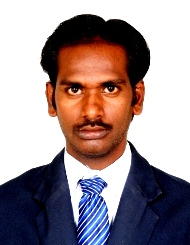
“Metal oxide based photocatalysts for environmental applications” Dr. Sivasankar Koppala Panjin Institute of Industrial Technology Dalian University of Technology Panjin 124221, Liaoning, People’s Republic of China
Brief description of talk: Over the few years, many semiconductor photocatalysts have been explored to degrade the emerging contaminants (e.g. dyes, antibiotics etc.) in the view of environmental protection. So far, TiO2 and ZnO photocatalysts are commonly used semiconductor materials because of its non-toxic, eco-friendly, low cost and high efficiency. But its use in practical applications limited due to wide band gap and high recombination rate of photo-induced electron-hole pairs. Decoration of noble metals on the semiconductors (TiO2 and ZnO) helps to solve these problems by surface plasmon resonance (SPR), which helps in enhancement in visible light absorption and hinders electron-hole pair recombination. In this talk, I will show the decoration of Ag on semiconductor materials (TiO2 and ZnO), study the structural/morphological features and enhanced photodegradation performance on emerging contaminants. Effect of noble metal concentration, SPR effect and plausible photocatalytic mechanism will be discussed.
Keywords: Metal Oxides; Photocatalysis; Dyes; Antibiotics;

“Computational materials design of halide double perovskites: Possible novel visible-light photo-catalysts” Dr. George Volonakis, Institut des Sciences Chimiques de Rennes, INSA, ENSR, Université de Rennes 1, France
Brief description of talk: Lead-based halide perovskites have emerged as the most prominent candidates for emerging photovoltaic technologies. In this talk I will briefly showcase recent efforts towards designing new Pb-free semiconductors that are alternatives to traditional halide perovskites, for which computational approaches from first-principles have been extensively successful and revealed a series of new compounds within the so-called halide double perovskites family and vacancy ordered perovskites. Among these, Cs2BiAgBr6 has the narrower indirect band gap of 1.9 eV, [1] and Cs2InAgCl6 is the only direct band gap semiconductor, yet with a large gap of 3.3 eV. [2] All of them exhibit low carrier effective masses and consequently, are prominent candidates for a range of opto-electronic applications such as photovoltaics, light-emitting devices, sensors, and photo-catalysts. [3-4] I will specifically outline the computational design strategy that led to the synthesis of these compounds, and particularly focus on the insights we can get from first-principles calculations in order to facilitate the synthesis, improve their opto-electronic properties and the in-silico identification of compounds with properties that are similar to the lead-halide perovskites.
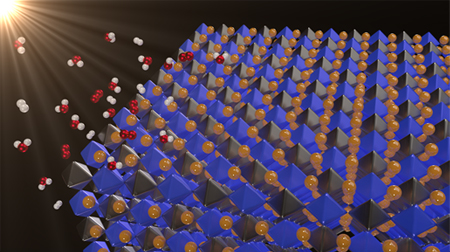
Within this talk, I will also showcase the power of calculations from first-principles to investigate the surface and interface properties of the newly designed compounds, and show how in fact Cs2BiAgBr6 andCs2BiAgBr6 are in for photocatalytic water splitting. The newly developed concept of analogs led us to identify a new oxide double perovskite semiconductor, Ba2AgIO6, which exhibits an electronic band structure remarkably similar to that of our recently discovered halide double perovskite Cs2AgInCl6, but with a band gap in the visible range at 1.9 eV. [5] In the last part, I will employ this strategy to explore the phase space of vacancy-ordered double perovskite and discuss the case of Zr-based compounds as alternates to Cs2TiX4 with X=Br,I. [6]
[1] G. Volonakis et al., Journal Physical Chemistry Letters 7 1254 (2016)
[2] G. Volonakis et al., Journal Physical Chemistry Letters 8 772 (2017)
[3] G. Volonakis and F. Giustino, Applied Physics Letters 112 243901 (2018)
[4] G. Volonakis et al., Journal Physical Chemistry Letters, 8 3917 (2017)
[5] G. Volonakis et al., Journal Physical Chemistry Letters, 10 1722 (2019)
[6] B. Cucco et al., Applied Physics Letters (under review 2021)
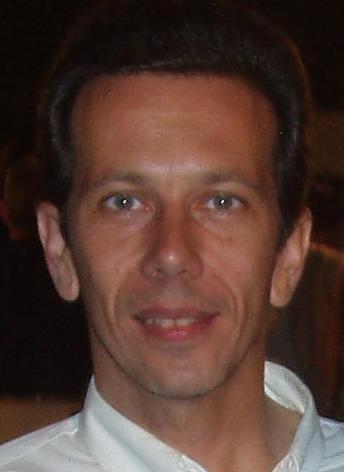
“Theoretical investigation of low-dimensional materials for photocatalysis” Prof. Georgios Kopidakis – Department of Materials Science and Technology, University of Crete and Institute of Electronic Structure and Laser, Foundation for Research and Technology-Hellas, Heraklion, Crete, Greece
Brief description of talk: Recent interest in photocatalysis is related to environmental concerns and to the search for viable methods for clean energy production and storage. Replacement of fossil fuels by sustainable energy resources may become possible by harnessing solar energy, provided efficient and cost-effective technologies are available for collecting, converting and storing this energy. Research activity to overcome these challenges is intense and focuses on the development of innovative materials and processes. Despite enormous progress in sunlight harvesting, photovoltaics (PVs) with combinations of band gaps designed to absorb within a large portion of solar radiation’s spectrum is an active field of research. The greatest challenge though is the storage of intermittent solar energy. An attractive option is to produce hydrogen, a good energy carrier, from electrolysis of water using electricity provided by PVs. Then, hydrogen and oxygen can be used in fuel cells to produce electricity and water. The best available catalysts are platinum-based materials and research in electrochemistry on inexpensive alternatives is ongoing. Photoelectrocatalysis, i.e., combining photovoltaics and electrolysis, requires considerable effort in designing stable, efficient, and inexpensive materials and devices. Molybdenum disulfide (MoS2) and other semiconducting transition metal dichalcogenides (TMDs) are promising materials for applications in optoelectronics and catalysis. Over the last few years, 2D and quasi-1D TMDs have attracted a lot of attention. We have studied theoretically TMDs, other emerging low-dimensional materials, and their heterostructures. TMD band gaps, which are in the visible range and become direct in atomically thin monolayers, as well as other electronic and dielectric properties, can be modified with dimensionality, strain, substrate, nanostructuring, etc. [1-4]. Focusing on the hydrogen evolution reaction (HER), we will present theoretical results based on density functional theory, which show that besides its active metallic edges [5], the otherwise inactive MoS2 basal plane becomes active by defects and transition metal doping [6]. We will discuss the potential of TMDs as cocatalysts in photocatalytic HER and environmental remediation together with some recent examples.
References:
[1] A.E. Maniadaki, G. Kopidakis, I.N. Remediakis, “Strain Engineering of Electronic Properties of Transition Metal Dichalcogenide Monolayers”, Solid State Commun. 227 33 (2016).
[2] D. Davelou, G. Kopidakis, G. Kioseoglou, I.N. Remediakis, “MoS2 Nanostructures: Semiconductors with Metallic Edges”, Solid State Commun. 192 42 (2014).
[3] A.E. Maniadaki, G. Kopidakis, “Hydrogen on Hybrid MoS2/Graphene Nanostructures”, Phys. Status Solidi RRL 10 453 (2016).
[4] D. Davelou, G. Kopidakis, E. Kaxiras, I.N. Remediakis, “Nanoribbon Edges of Transition-metal Dichalcogenides: Stability and Electronic Properties”, Phys. Rev. B 96, 165436 (2017).
[5] D. Davelou, C. Mathioudakis, I.N. Remediakis, G.Kopidakis, “Transition Metal Dichalcogenide Nanoribbons: Low – dimensional Electrocatalysts for HER”, to be submitted.
[6] M. Minotaki, G. Kopidakis, “Molybdenum Disulfide Defects and Transition Metal Dopants for Hydrogen Evolution”, to be submitted.
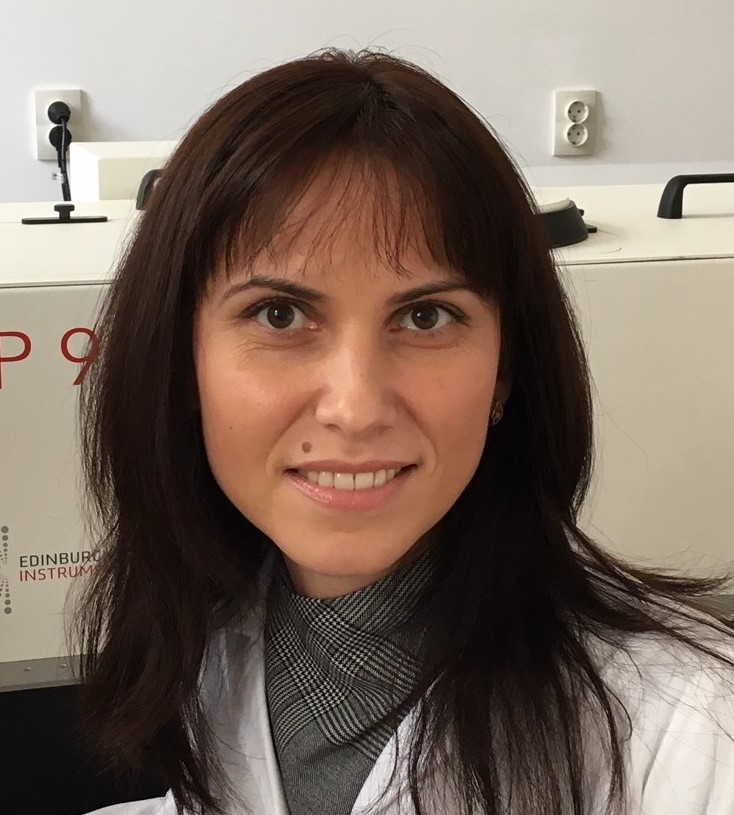
“PVDF fibers embedding lanthanide doped ZnO membranes for adsorption and photocatalytic degradation of dye organic pollutants” Dr. Petronela Pascariu – Petru Poni Institute of Macromolecular Chemistry, Iași, Romania
PVDF fibers embedding lanthanide doped ZnO membranes for adsorption and photocatalytic degradation of dye organic pollutants
Petronela Pascariu, Corneliu Cojocaru, Anton Airinei and Mirela Suchea
Brief description of talk: New hybrid materials based on lanthanide doped ZnO nanoparticles (Ln=Sm,La,Er) [1,2] reinforced in PVDF membranes were prepared by electrospinning method, materials that have not been reported so far. The materials were evaluated in terms of crystalline structure (XRD), surface morphology (SEM), mechanical and adsorption/desorption properties. SEM measurements highlighted a continuous, uniform, and bead-less formation in the optimal electrospun conditions morphology. The results from the mechanical evaluation showed that PVDF/ZnO:Ln nanostructures had higher values of the elongation at break as compared to pristine PVDF. As the ZnO:lanthanide level increased, the elongation at break increased too. Thus, the elongation at break for pristine was 45.49 MPa, and for the materials containing 37 % ZnO:lanthanide was up to 71.09 MPa. The photocatalytic activity towards MB (10 mg/L) and RhB (5 mg/L) degradation under visible light irradiation was performed for all prepared materials. The excellent color removal efficiency was up to 96.33 % for MB and 93.36 % for RhB removal for the membrane containing 37 % ZnO:La. The results were validated by the photodegradation kinetics evaluation which followed a pseudo-first-order kinetic model. The calculated values of the rate constants were between 10−3 to 10−2 min−1, depending on the percentage of ZnO:lanthanide and initial dye concentration. Moreover, the materials could be recovered and reused even after five repeating cycles with the photocatalytic activity up to 98 %. In addition, it can be pointed out that the degradation process takes place in the environment-friendly conditions (under visible light irradiation), promoting this way the applicative potential of the present PVDF/ZnO:Ln membranes in industrial dye wastewater treatment.
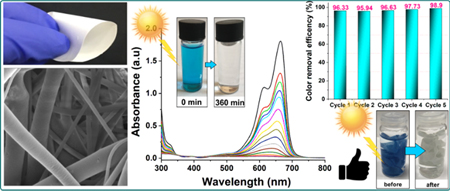
Acknowledgment: This work was supported by a grant of the Romanian Ministry of Research, Innovation and Digitization, CNCS/CCCDI – UEFISCDI, project number PN-III-P1-1.1-TE-2019-0594, within PNCDI III.
References
[1] P. Pascariu et al., J. Environ. Manag. 239, 225–234 (2019).
[2] M. Homocianu, P. Pascariu, Polym. Rev. 60, 493–541 (2020).

“Halide Perovskites: The Emergence of a New Class of High-Performance Semiconductors” Assoc. Prof. Dr. Constantinos Stoumpos Department of Materials Science and Technology, University of Crete, Heraklion 71003, Greece
Brief description of talk: Halide perovskites is the new edition of the namesake family of materials that has revolutionized science, from the discovery of high-performance ferroelectrics (BaTiO3) and high-Tc superconductors (YBa2Cu3O7) for over a century (1). The most recent iteration of perovskites -the emerging class of halide perovskites- is a family of high-performance semiconductors which operate in the visible and infrared energy range. These materials, known for over a century, were suddenly brought back to life in the 1990’s with the pioneering work of D.Mitzi (2) and G. Papavasiliou (3), but the genuine breakthrough came in 2009, when T. Miyasaka and co-workers demonstrated that the hybrid organic inorganic perovskite, CH3NH3PbI3, can be employed in photovoltaics (4). What followed since this original discovery was a resurgence of interest for these materials resulting in a highly competitive research race towards solution-processable, cost-efficient and high-performance solar cells. To date this race is still raging, reaching record power conversion efficiency of ~25%, pending commercialization. Along the rapid development of solar cell technologies, it also became apparent that halide perovskites possess altogether remarkable semiconducting properties applicable to all field of optoelectronics. These remarkable physical properties derive from their unique electronic structure, which lends the semiconductors high absorption coefficients and charge-carrier mobilities.
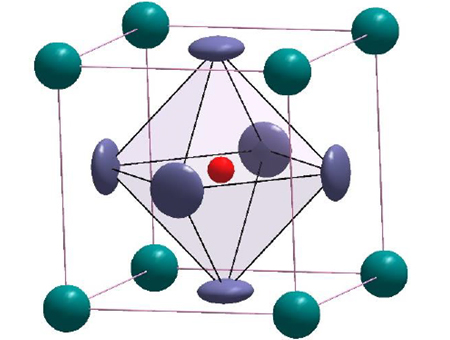
In this presentation I will outline the compositional space of the halide perovskites, AMX3, (A+ = Cs, CH3NH3, HC(NH2)2); (M2+ = Ge, Sn, Pb); (X- = Cl, Br, I) and explain the crystal chemistry of the materials, as well as their low-dimensional and compositional derivatives. I will discuss how small changes in the crystal structure can significantly alter the optical, electrical and electronic properties of the perovskites and I describe how these can be controlled by targeted chemical synthesis. Lastly, a brief synopsis of how halide perovskites can be applied in optoelectronic devices, tackling device-specific problems such as environmental instability and toxicity will be presented
CCS acknowledges support from the project “NANO-TANDEM” (MIS5029191), co-financed by Greece and the European Regional Development Fund and the from the Special Account for Research Funding of the University of Crete under grant numbers KA10330 and KA10652.
References
(1) C. C. Stoumpos, M. G. Kanatzidis, Adv. Mater. (2016) 28, 5778-5793
(2) D. B. Mitzi, Prog. Inorg. Chem. (1999) 1-121
(3) G. C. Papavassiliou, Prog. Sol. State Chem. (1997) 25, 125-270
(4) A. Kojima, K. Teshima, Y. Shirai, T. Miyasaka, J. Am. Chem. Soc. (2009) 131, 6050–6051

2D/2D Heterojunction Photocatalysts for Sustainable Energy and Environmental Applicationss” Dr. Kishore Sridharan – Department of Nanoscience and Technology School of Chemical and Physical Sciences,University of Calicut 673635
Kerala, India
Brief description of talk: Recently, the construction heterojunction photocatalysts, especially 2D/2D systems with two dissimilar layered semiconductors in face-to-face contact has drawn immense attention due to their synergistic influence. 2D layered structures of Bi-rich BixOyXz are active semiconductor photocatalysts with higher photon absorption efficiency, which induces greater electric field intensity and subsequently leads to large dipole moment. The larger dipole moment and wider interlayer spacing in BixOyXz boosted by the large polarization force and polarization space lead to increased internal electric field, which in turn enhances the separation efficiency of the photogenerated charge carriers. Also, as suggested by recent studies sandwiching 2D layered semiconductors of BiOX/BixOyXz and g-C3N4 conveniently promotes the formation of a heterojunction that can facilitate enhanced photocatalytic performance aided by their favorable band positions. In this talk, I shall be summarizing some of the recent advances of BiOX/BixOyXz-g-C3N4 heterojunction photocatalysts for selective applications. Also, the perspectives and plausible opportunities in the development of high performance BiOX/BixOyXz-g-C3N4 heterojunction photocatalysts shall be discussed.
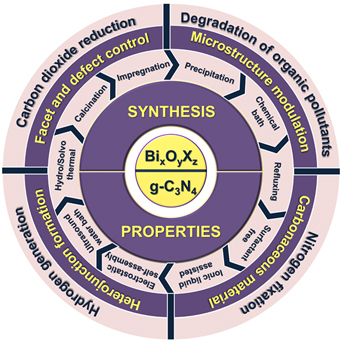

“Atomistic modeling in Photocatalysis” Prof. Dr. Núria López, ICIQ-Institut Catala d’Investigacio Quimica, Tarragona, Spain
Brief description of talk: Photo and photoelectrochemical processes require the fine tuning of the properties of the adsorbers and the materials acting as catalysts. In the present talk I will revise some of the latest developments in our group that demonstrate the need to understand how interfaces work and the challenges ahead in this type of modeling.

“Antibacterial Textiles Using Visible Light Using Manganese Doped TiO2 Nanoparticles” Dr. Evie L. Papadopoulou – Smart Materials Group, Istituto Italiano di Tecnologia (IIT), Genoa, Italy
Antibacterial Textiles Using Visible Light Using Manganese Doped TiO2 Nanoparticles
Muhammad Zahid, Evie L. Papadopoulou, Giulia Suarato, Vassilios D. Binasb, George Kiriakidisb, Iosifina Gounaki, Ourania Moira, Danae Venieri, Ilker S. Bayer and Athanassia Athanassiou
Brief description of talk: Moisture, different contaminants and sweat that constitute their micro-climate, favour microbial and bacterial growth in textiles, while in use. Hence, textiles can easily become malodorous and the source of cross-infections. It is then evident that following hygiene, but also comfort, requirements, that functionalization of textiles in order to gain antibacterial activity, as well as self-cleaning properties are of paramount importance. To this end, simple approaches of surfaces modification using different functional materials have been widely used.
Here, we present a simple and low-cost technique to prepare antibacterial, photocatalytic and self-cleaning cotton textile fabrics. The fabrics were functionalized by spray coating with manganese (Mn)-doped photocatalytic titanium dioxide (TiO2) nanoparticles, using polydimethylsiloxane (PDMS) as binder. The TiO2:Mn nanoparticles were prepared by a sol gel method, followed by mill balling to achieve an average diameter of approximately 100 nm.
Different TiO2:Mn and PDMS ratios were used, and subsequently, the treated fabrics were characterised for their chemical and physical properties. The functionalisation did not result in alteration of the mechanical properties of the textiles, in particular the mechanical properties worsened less than 20% and porosity was found to be similar to the untreated fabrics. Furthermore, the functionalized fabrics were characterized for their anti-bacterial properties against both against S. aureus (Gram-positive) and K. pneumoniae (Gram-negative) bacteria, and displayed 100% reduction of both kinds of bacteria within 120 min under natural sunlight. Finally, the treated fabrics demonstrated complete photocatalytic degradation of methylene blue (MB) dye adsorbed on their surface under both UV and visible irradiation, turning them white.
In addition, the modified fabrics were also resistant to several laundry cycles. Physical properties like mechanical strength, colour, breathability and aesthetic of the prepared cotton fabrics remained unchanged. The presented modified cotton fabrics can be envisioned as antibacterial, anti-odorous and self-cleaning textiles for sports, medical uses, uniforms, fashion, home furnishing and leisure activities.

“Co-creation of future cities – EFdeN Sustainable City” Ioana Csatlos – Sustainable Development Manager, Deputy Chairman ASDB, EFdeN Romania
Brief description of talk: EFdeN is one of the most well-known student NGOs in Romania that works in the field of sustainability. We are a multidisciplinary team of over 60 students and recent graduates of various specializations, passionate about sustainability and change.
Our projects provide volunteering students with a great opportunity for practical and accelerated professional and personal development. We address 5 different public segments: students, children and teenagers, companies and the general public. We host events, workshops and develop educational programs in a non-formal environment.
We develop projects and people who want to recreate Romania and the cities in which they would like to live. We focus on sustainability and climate change, youth and the environment.
In all activities we follow the development directions proposed by the UN for 2030, adhering to the Sustainable Development Goals.
A sustainable city starts with small steps.
EFdeN Sustainable City project will allow visitors to experiment what it would be like to inhabit a city like this, aiming to transform the cities we live in for the next generations.
We are showcasing elements of a smart and sustainable city and the way they work together, by representing 8 of these main components through practical projects and themed areas, testing them and communicating the results.
The 2 houses EFdeN has developed in the past 6 years are placed next to each other, working as a combined research center for new projects.
We have to accelerate the transition towards a clean energy economy. At EFdeN we have 2 solar houses that are 100% electrical, 2 solar trees and 2 charging stations for electrical vehicles that will work on a smart grid changing energy between them. All of these in a green campus where students and professionals can work outdoors, with free energy and wi-fi.
We encourage smart mobility with the use of bicycles and electrical scooters, which is why we will integrate renting and charging stations for them. In order to lower our CO2 footprint as much as possible, we have also developed a self-sustainable solar charging station for electrical vehicles.
We encourage reducing your generated waste, using recycled materials and selective collection.
Therefore, we want to integrate recycling and composting stations to divert as much landfill waste as possible.
Both EFdeN houses were designed to integrate the urban farming concept. Both inside the houses as well as around them we support domestic harvest of productive plants in the urban area, as a healthy and economical alternative for the inhabitants.
We spend 80% of our time inside buildings and this affects our health and productivity. The Sick Building Syndrome is one of the subjects we have approached in developing The Guide of Comfort Conditions.
We want to extend our activity range, in the field of Health & Well-being, with guides, events and activities in sports and nutrition.
And last but not least, innovation for a circular city.

